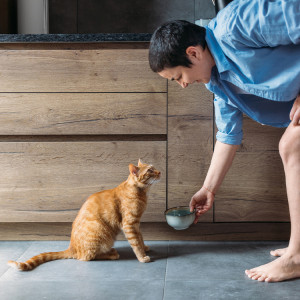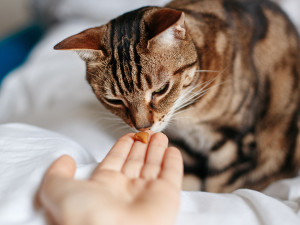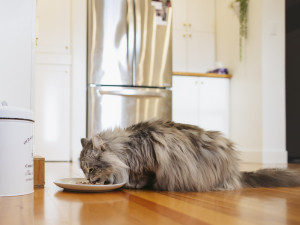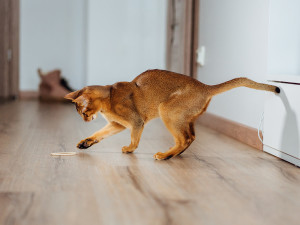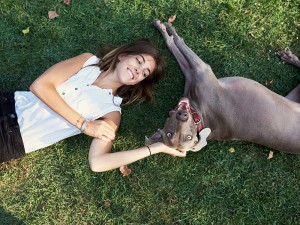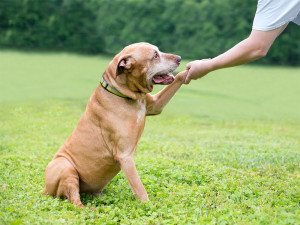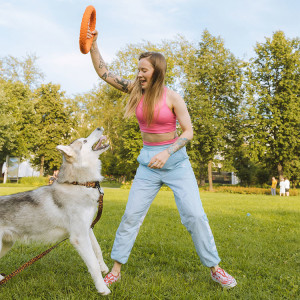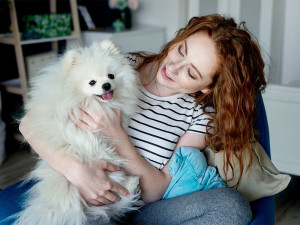10 Longevity Tips From People Whose Pets Have Lived Incredibly Long Lives
Follow these vet-backed tips to help your best bud live a healthy and full life.
Ever feel like your pet is your actual salvation? You’re not alone. According to the American Psychiatric Associationopens in new tab, 87 percent of dog parents and 86 percent of cat parents say their pet has a positive impact on their mental wellbeing. This includes providing comfort and unconditional love, mitigating stress, and relieving loneliness.
By the same token, a vast majority of those pet parents (71 percent to be specific) were also concerned about their furry loved ones getting older and passing away. Aging is, of course, inevitable, and one of the most challenging realities of being a pet parent is knowing you’ll most likely outlive your cat or dog.
We can’t cheat nature, but we can take measures — from their childhood to their senior years — to improve our pet’s quality of life, and perhaps even extend their precious time with us. With this in mind, we reached out to a handful of pet parents, whose beloved cats and dogs lived well into their golden years, to see if they had any longevity tips — and of course, we got a vet’s take, too.
Below, tips to improve the longevity of your beloved pet from nutrition and supplements to simply how you interact with your favorite friend.
How much do you spend on your pet per year?
1. Always consider nutrition.
Jeremiah, whose cat, Totoro, lived to age 16, chalks up their longevity to nutrition. “Totoro came to me as a kitten, an inch from death…the shelter was about to put him down,” Jeremiah says, referring to the intestinal infection that almost took his life. “He was a miracle baby.”
For the last decade of Totoro’s life, Jeremiah invested the time, energy, and money into making his cat’s meals from scratch: “He got organic food that I was cooking myself. He’d eat chicken, green peas, carrots.…”
Vet perspective:
Whether you have a cat or a dog of any age, Kinship Collective member Dr. Lindsey Wendtopens in new tab, owner and creator of Crystal Lotus Veterinary Careopens in new tab, agrees that nutrition is key. “More than anything, nutrition is truly the foundation of health,” she says. “Optimizing nutrition despite their age, whether they’re young, middle-aged, or even older, we can always make an impact. Investing in high-quality nutrition early on, really does help when we’re talking about longevity and health.”
She suggests a gently cooked or raw-food diet like Totoro’s for dogs and cats, but realizes that’s not realistic for all pet parents — so canned food is the next best thing. “At least with canned food, we’re giving them a lot of moisture,” she says. Which brings us to our next tip.
2. Keep them hydrated with wet food.
It’s not easy to get a cat to drink water — any cat parent knows that. Even if you’ve splurged on a fancy water fountain, they seem to only want to drink water out of the glass next to your bed every three days. Well, one thing Jo, whose cat, Comrade, lived just shy of 18 years, says to do to them hydrated is make sure they are eating wet food instead of dry food — this also plays into nutrition.
“The simple act of hydrating your cat could spare them from kidney issues sooner than later in life,” Jo says. “Wet food is necessary to sneak in that extra hydration. You can also maintain a healthier weight and easier with wet food.”
Vet perspective:
Dr. Wendt agrees about wet food. “The way that cats have developed, they’re almost like a desert species,” she says. ��“So, they’re made to really concentrate their urine. And so they are impacted even more by feeding foods that are devoid of moisture.” Not only will your cat (or dog) get more moisture with better food, she says they will also drink more water if they have a “biologically appropriate diet.”
3) Get your vegetables.
“The number-one thing I talk about all the time with other [pet] parents is keeping their weight in a healthy range,” Bonnie says, whose Miniature Dachshund, Penny, is nearly 18 years old. She used to lean on wet food for that, but when the pandemic hit, canned-food prices surged. Although canned is preferred for hydration and nutrition, Bonnie found a great hack to keep Penny healthy and strong.
“I was like, ‘I can’t maintain this on a fixed income.’ And I would rather have the funds for her medical care. So, I started giving her kibble with vegetables like raw green beans and raw peas,” she says. “The vet recommended that I just throw in some frozen mixed vegetables. She’s been happy, and her poops are perfect.”
With the latter in mind, Bonnie also slips a little fiber-rich pureed pumpkin into her kibble. “Just make sure you pay attention that you’re not buying pumpkin-pie filling, which is cooked with all the spices and not good for them,” she warns.
Vet perspective:
Dr. Wendt encourages dog parents to follow Bonnie’s lead when it comes to veggies. “For the most part, I do recommend that people gently cook vegetables so that they’re easier to absorb: carrots, kale, even mushrooms,” she says. “There are some things that are toxic, so make sure you’re never giving them onions or grapes or raisins. But a lot of the foods that we’re eating and prepping for ourselves — if you just make a bland version for your dog — it’s OK to add in.”
But remember to mix it up. “Variety is really important,” she says. “You don’t want to feed spinach all the time because it’s high in oxalic acid and then that can lead to urinary stones.”
4. Don’t forget about their teeth.
Today, Jo applies much of what she learned from bettering Comrade’s quality of life to her younger cat Callooh — especially when it comes to his teeth. “We give him a dental plaque powder, because the bacteria that can cause dental problems can also cause problems in other systems.”
Vet perspective:
Dr. Wendt cosigns Jo’s attention to dental health. “She is correct that dental disease is a huge issue,” she says. “It contributes to cognitive decline, heart disease, and kidney issues.” She recommends diets rich in raw, canned, or gently cooked foods that are low in carbohydrates to mitigate dental disease. And if you’re looking for a supplement, try an antiseptic-free water additive, such as the one from Healthy Mouthopens in new tab, alongside brushing (attempting to) your cat’s teeth with either a child-size toothbrush or even a Q-tip at least three to four times a week.
When it comes to dogs, dental care is just as important. Dr. Daniel T. Carmichael, a veterinarian and board-certified veterinary dentist who practices at Animal Medical Centeropens in new tab in NYC and The Veterinary Medical Center of Long Islandopens in new tab, told Kinship that periodontal disease is the most common disease in dogs, affecting 85 percent over the age of three. The best way to prevent bacterial plaque from accumulating on your dog’s teeth is by brushing them (no toothpaste needed) daily.
For dental health for both cats and dogs, Dr. Wendt also points patients to TEEFopens in new tab, a water additive that will “balance out their microbiome.”
5. Figure out the right outdoor/indoor situation.
Sure, you take your dog on walks, but when Cindy, whose Catahoula / Heeler mix, Daisy, lived to age 14, realized how much all her dogs (she has four in total now) loved going outside — beyond hikes and walks — she installed a custom-made doggie door.
“They can go outside whenever they want and come back in whenever they want. They have so much freedom,” she explains. “I would never, like, put them outside and leave them out there. But they can stay out as long as they want and come back inside. They’re living a good life.”
When it comes to cats, Jeremiah and Jo think keeping them indoors will help them live longer.
“Cats’ paws touch the surface of things, right?” he says. “So they’re going to, like, touch fluids coming out of a car, because they love to go under cars. They’re just taking in all of these toxins.” This includes other contaminants, such as outdoor cleaning materials and the various chemicals used by exterminators, all of which cats may ingest due to their tendency to clean themselves. Jo concurs, adding “Cats who are indoor-outdoor have a much greater chance of getting feline HIV. That can be from fighting or sharing water bowls or sharing food.”
Vet perspective:
While Dr. Wendt understands the cat parents’ worry over toxin exposure, predators, and getting hit by cars, she does think a little fresh air is beneficial — depending on the cat. “The outdoors is not only good for their physical health, but also for their mental health,” she says. “I encourage some people to harness-train their cat and take them outside for little adventures.” She also recommends, if you have the space and means, building an enclosed patio or some sort of outdoor exposure for them.
6) Treat your pet how you would like it to be treated.
“I credit my dog’s longevity to the fact that I’m in the same stage in my life,” says Bonnie, a senior herself. “I just think about how I would feel if I were rushed or if nobody listened to me. Keeping these stressors out has benefited me, too.” Penny is also on Prozac for anxiety. “I fought it for many years, but I finally relented. And you know? It helped her to be herself again. It was almost like a miracle.”
Vet perspective:
Ultimately, day-to-day ease of life is an intangible difference-maker. “Anytime we’re stressed or angry, we put off pheromones,” Dr. Wendt says. “It’s silent communication our pets can pick up on it, and it does affect them systematically. It’s beneficial for all of us if we create a foundation of calm in the household. Animals really respond to that.”
7) Keep up an exercise routine.
As your dog ages, it’s important to get in those walks you’ve always done, even if they are a little slower and shorter. Cindy emphasizes keeping a routine — just making sure it’s at their pace. “We didn’t stop doing anything, but it was up to her,” she says. “She would still run down a block, and I’d let her just run. I mean, don’t start treating them like they’re invalids or something. They really do want to keep going until they can’t.”
Vet perspective:
“As long as your dog can go for a walk every day, it’s really helpful for them — it’s good for their gut health and for their mental health,” Dr. Wendt says. “If we don’t walk dogs that are arthritic because they’re uncomfortable, we are unfortunately contributing to their arthritis worsening because then they get muscle-mass loss, and then they’re very weak.”
8) Consider supplements.
Our pets can be more like us than we think: They can come with vitamin deficiencies and pre-existing conditions. So, it’s never a bad idea to invest in supplements that can enhance their wellbeing — and may ultimately save you a lot in healthcare costs.
As mentioned previously, Jeremiah was cooking meals for his cat Totoro. “I went on the internet to look for the best homemade cat recipes,” he says. “But that’s trial and error, so you really need to take them in for blood work.” After closely monitoring Totoro’s health with his vet, Jeremiah realized he still needed to supplement the meals with amino acids and potassium.
Jo currently gives her cat Callooh an immunity supplement called Lysine and a probiotic. “These are all powders that we add to his wet food,” she says.
Vet perspective:
For cats, Dr. Wendt recommends fish oils (which support skin health, immune health, kidney health, and heart health), prebiotics, and probiotics as go-to supplements. “When people are like, ‘I want my cat to live forever,’ I recommend functional mushrooms. Reishi in particular, supports longevity.”
For dogs, she suggests omega-3 fatty acids, prebiotics, and probiotics, and again, mushrooms. “Mushrooms are one of the biggest hidden treasures by far.” She’s also a fan of Pet Matrxopens in new tab’s powdered peptides, for cognitive and mobility support. “I’ve literally had people within two weeks see huge shifts.”
9) Spend quality time with your pet.
Dogs often become so bonded to their human parents that every little thing you do makes a difference in their quality of lives. Cindy is all about mom-pup time. “Daisy and I were going on walks, playing ball,” she says. “We would still do our things around town.“
Vet perspective:
A little TLC goes a long way. “Just spending a little bit of time with them, giving them intense attention and really focusing on them, those little investments make a huge difference,” Dr. Wendt says.
10) Give them what they love.
Bonnie’s dog Penny is arthritic these days, so when they go on walks it’s a little bit different than it used to be, but she still loves it. “I don’t focus so much on exercise, as I do on enrichment,” she says. “But boy, she’s still as curious as she ever was! Those sniff walks, you know, make her so happy. You just watch her tail and know she's having a good time."
Penny also loves a good ear massage. “I did my own little inservice on how to scratch a dog behind their ears. They’ve got so many muscles there, because their ears go in all these different directions,” Bonnie says. “Now she will not get off the bed in the morning until I do that little massage. And I kiss her and ask her about her puppy dreams. And I let her see me smile. I mean, it’s simple: Smiling makes everyone feel better.”
Vet perspective:
Dr. Wendt recommends any holistic treatments that will bring your pet relief as well. “Massaging is great and something you can do at home, which does have therapeutic benefits,” she says. And if you have a bigger budget, she says acupuncture is also fantastic. “I use it to treat almost anything. And I use a lot of ozone therapy, because it’s antiviral, antibacterial, and anti-inflammatory.”


